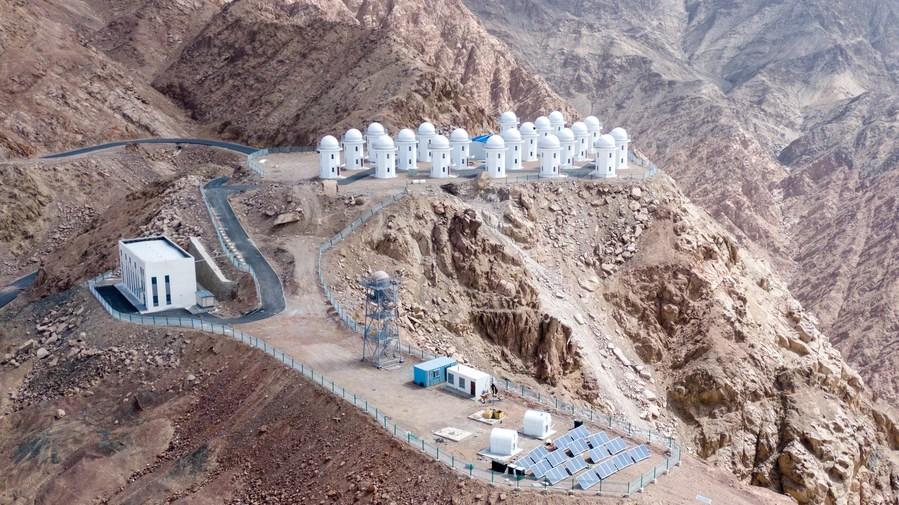

This aerial photo taken on April 12, 2023 shows an astronomical telescope project of the Lenghu observatory site
under construction in northwest China's Qinghai Province. [Photo/Xinhua]
Lenghu, a tiny town with about 500 permanent residents at an average altitude of 2,800 meters, will soon draw worldwide stargazers with a state-of-the-art observatory site located in northwest China's Qinghai Province.
China's top astronomers have chosen the area as an ideal observatory site, thanks to its clear night skies, stable atmospheric conditions and dry climate comparable to several globally-renowned observatories.
Construction of the Lenghu site started in 2018. Upon its completion it will house at least nine optical astronomical telescope projects including some 30 telescopes, with an investment of nearly 2 billion yuan (about 289 million U.S. dollars).
"With the new observatory in sight, Lenghu is gaining popularity and attracting more tourists," said Zhang Jing, who works at a hotel in Lenghu town.
She said the hotel plans to revamp its guestroom windows to offer astronomy lovers a better view of the starry night sky.
Star-gazing from "roof of the world"
Chinese scientists first looked to the Qinghai-Tibet Plateau, known as the "roof of the world," as a potential observatory site in the 1990s and have located a series of observatory sites on the plateau since 2000, including one in Ngari Prefecture in the Tibet Autonomous Region.
In 2017, Tian Cairang, then deputy Party chief of the Lenghu industrial park, was anxiously seeking new ways to facilitate local industrial transformation as the small plateau town, which saw a short-lived economic boom in the 1960s due to its oil reserves, had fallen into recession in the 1990s due to resource depletion.
"At night, when we looked up at the sky, we saw the brilliant stars," Tian said in an interview with Xinhua. "The stars seem incredibly close, and the Milky Way so clear. I asked myself this question: can Lenghu rely on its starry sky to develop the cultural tourism industry?"
He invited Deng Licai, a researcher from the National Astronomical Observatories under the Chinese Academy of Sciences (CAS), to visit Lenghu.
Deng was struck by the starry sky once he climbed to the top of the Saishiteng Mountain east of Lenghu, about 4,000 meters above sea level. "It was dark, dry and barren up there, so it might be an ideal site for astronomical observation," he recalled.
Deng and his colleagues eventually identified the site in 2021, after three years of survey which found 70 percent of the nights at Lenghu had clear, photometric conditions, with a median seeing of 0.75 arc seconds and a precipitable water vapour below 2 mm for 55 percent of the night. These qualified the place as an ideal astronomical observing site, Deng said in a paper published in Nature in 2021.
Cutting-edge technologies
Deng said it broke the bottleneck in China's development of optical astronomical observations and will fill the gap in global research.
"Without a cutting-edge observatory here, we miss out on important celestial events that occur in the Western Hemisphere during the day, which is nighttime in the Eastern Hemisphere," Deng said, adding that the site will enable worldwide scientists to expand cooperation.
Among these newly-built projects, a new solar telescope is in the trial run stage.
The Accurate Infrared Magnetic Field Measurements of the Sun (AIMS) is the first solar magnetic-field telescope working in the mid-infrared wavelength in the world, said Wang Dongguang, chief engineer of CAS's Huairou Solar Observing Station of National Astronomical Observatories.
Solar observations in the mid-infrared range have been a challenge for worldwide astronomers, Wang said. The new facility is expected to obtain highly accurate data of the solar magnetic field, mid-infrared imaging and spectrum.
Another project, the Stellar Observations Network Group (SONG) project, with a total investment of 30 million yuan, is undergoing dome installation.
"Instead of using air conditioning inside the dome, we have designed it specifically for thermal and wind dynamics. The new design uses wind to control its inside temperature and air flow, significantly improving the telescope's dome seeing," said Deng.
Once completed, it will join seven other telescopes worldwide to study the internal structure of stars and explore extrasolar planetary systems, said Deng, Chinese representative of the steering committee of the SONG project that involves about 20 countries.
The Multiplexed Survey Telescope (MUST) construction project was also launched in Lenghu last year. The 6.5-meter MUST, developed by Tsinghua University, will be the largest telescope in Lenghu upon completion. Scientists hope to make breakthroughs in dark energy evolution, gravitational wave cosmology and galaxy formation.
With more infrastructure and further testing, Deng said Lenghu would become a major base for international optical astronomy research, as well as a source for humanity to explore the mysteries of the universe and cultivate original scientific achievements.
A future nurtured by science
Retired local government worker Zhang Yaping follows the building progress of the observatory site in her hometown.
At 56, Zhang vividly remembers her childhood living on an oil production base near Lenghu.
"The town has no summer as a cold wind persistently blows, and the weather is dry all year round," she recalled.
As she grew up, Zhang witnessed Lenghu's prosperity and decline and took part in its development.
"Before 1958, it was a town of tents pitched by geological exploration teams in search of oil," said Zhang, former head of Lenghu town.
In September 1958, when the Lenghu oilfield was discovered, then dubbed one of China's four major oil zones, people flocked in from all over the country. The town gradually became prosperous, and its population reached 100,000 at its peak, statistics show.
But its boom based on oil resources was short-lived: when the oilfield dried up in the late 1980s, many new settlers left and the town fell back into oblivion.
"Although the town's cultural history is short, its future must be bright," she said. "Lenghu's future lies in astronomy, science and technology."
